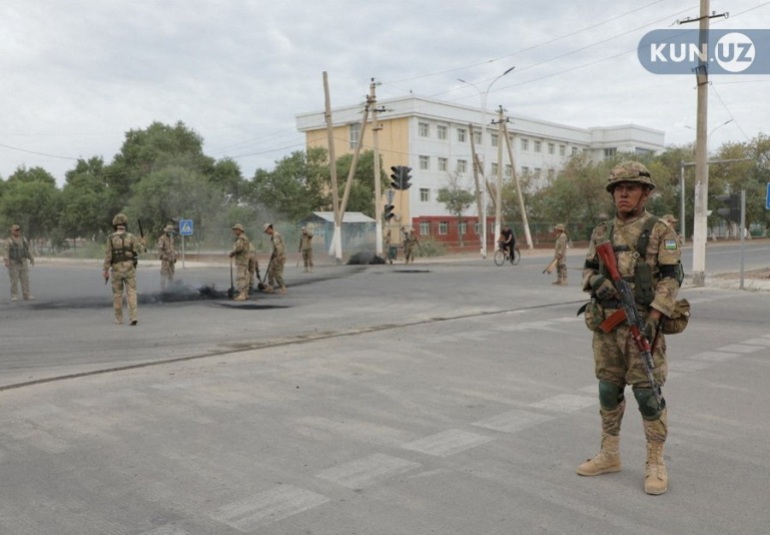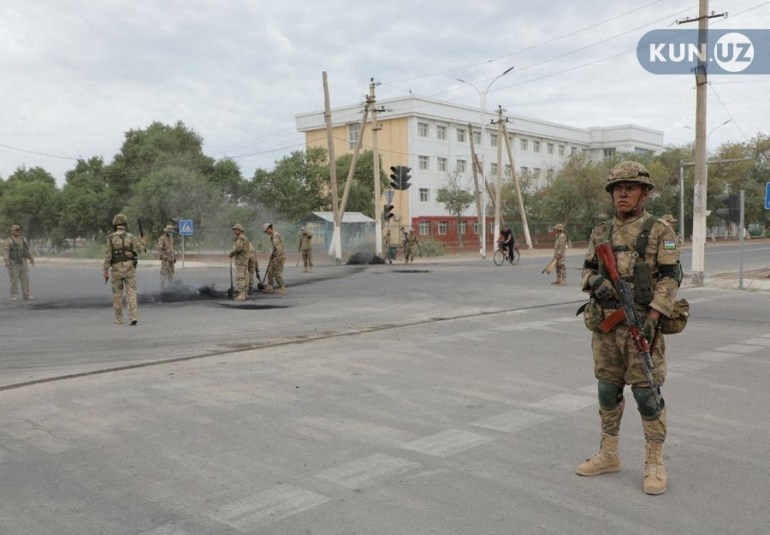What we know about protests in Uzbekistan’s Karakalpakstan region | Protests News

Rare protests in Uzbekistan’s autonomous Karakalpakstan region turned deadly last week, according to the government, as President Shavkat Mirziyoyev faced growing calls to allow an independent investigation into the violence.
Thousands of demonstrators took to the streets on Friday in opposition to proposed constitutional reforms that would have refused the province, which borders Kazakhstan and the Aral Sea, the right to secede.
Under the current constitution, the sprawling Karakalpakstan, home to a diverse population of two million people including ethnic Karakalpaks which accounts for about 40 percent of Uzbekistan’s territory, is described as a sovereign republic within Uzbekistan and has the right to secede by holding a referendum.
Mirziyoyev has since abandoned the amendment while imposing a month-long state of emergency in the region, where the flow of information has been stifled by reported internet suspensions since last week.

Here is what we know about the protests so far:
Eighteen dead and 243 wounded
Uzbek authorities said on Monday that 18 people were killed and 243 were wounded during the protests. The national guard said 516 people were detained but have since been released.
Mirziyoyev, who pledged a raft of human rights reforms after taking office in 2016, has said there were “civilians and law enforcement officers” among the dead. Authorities have not offered further details of the identities of those killed or how they died.
The government has said protesters marched through the provincial capital of Nukus on Friday. They accused protesters of throwing stones, starting fires and attacking police, as well as trying to storm local government buildings.
A joint statement by the province’s police, parliament and cabinet said that “provocateurs” had attempted “to seize state institutions… split society and destabilize the socio-political situation in Uzbekistan.”
#Uzbekistan: @EU_EEAS calls for open & independent investigation into violent events in #Karakalpakstan.
EU should also have denounced Internet & mobile shut down in the region & press for any emergency measure to be proportionate and right-respecting.https: //t.co/YCXGpsXhfb pic.twitter.com/AixsBKVx6Y
– Philippe Dam (@philippe_dam) July 4, 2022
Unverified videos posted online have shown thousands of protesters marching in Nukus. Some have purported to show wounded protesters bleeding on the streets.
Photographs published on Sunday by the Kun.uz news site showed street barricades, burned trucks and a heavy military presence including armored personnel carriers.
Meanwhile, rights groups have said the central government has suspended internet in the region since last week.
On Saturday, the government imposed a month-long state of emergency in the province to “ensure the safety of citizens, protect their rights and freedoms (and) restore law and order,” Mirziyoyev’s Press Secretary Sherzod Asadov wrote on the Telegram app.
The state of emergency included a curfew but further details were not immediately released by the government.
Calls for independent investigation
On Monday, the European Union called for “an open and independent investigation into the violent events in Karakalpakstan” and called on “all sides to show restraint in their actions”.
The EU also called on “authorities to guarantee human rights, including the fundamental rights to freedom of expression and freedom of assembly, in line with Uzbekistan’s international commitments”.
Speaking to Al Jazeera, Hugh Williamson, the director of the Europe and Central Asia division at the New York-based Human Rights Watch (HRW), called the “high death toll” very concerning.
He also said there were concerns that “independent reporting is not being allowed” in Karakalpakstan after a correspondent from Eurasia.net was detained on Monday, following her reporting in Nukus. She was later released.
Williamson said HRW was calling on the government to reverse suspensions of mobile and fixed-line internet connections in Nukus and urged Mirziyoyev to live up to his promises of reform.
“This is a good opportunity for it to prove that it respects basic human rights, it investigates what’s happened, and in particular, it brings to account the police or security forces that may or may have carried out these killings,” he said.
Regional response
The protests represent the second significant instance of unrest in Central Asia this year, after Kazakhstan in January crushed mass protests. At least 227 people were killed in that crackdown, with nearly 10,000 arrested.
Forces from the Collective Security Treaty Organization (CSTO) – which includes Kazakhstan, Russia, Armenia, Belarus, Kyrgyzstan, Tajikistan and Kazakhstan – were also deployed to the country at the request of Kazakhstan President Kassym-Jomart Tokayev.
The Reuters news agency reported that Mirziyoyev spoke to Tokayev on Monday. The Kazakh president’s office later said Tokayev welcomed Tashkent’s measures to ensure stability in Karakalpakstan. Kazakhstan is home to the largest Karakalpak diaspora abroad.
Uzbekistan is not a member of the CSTO or any security alliance with Russia, and while maintaining close ties to Moscow, has increasingly developed relations with the US, the EU and China in recent years.
Kremlin spokesperson Dmitry Peskov on Monday called Uzbekistan a “friendly country” and said the protests in Karakalpakstan were an “internal matter” that it was confident Tashkent would resolve.

